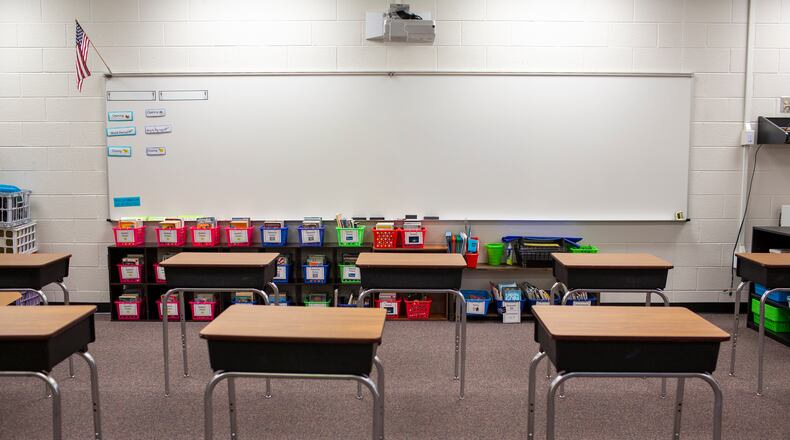Metro Atlanta districts are offering up a varied menu of return-to-school plans, face-to-face instruction Monday, online Tuesday, hybrid Wednesday, chicken pot pie Thursday and casual Friday.
Looking at their reopening plans is like watching a horror film where the next victim edges down a dark hallway toward doom rather than running for the door.
You want to leap out of your seat and plead, “Turn back. Save yourself.”
“Understandably and appropriately most of the focus is on protecting students and providing them with the in-person learning that is so incredibly vital to their development,” said Georgia education professor Bryan Sorohan. “But unfortunately there seems to also be a major focus on getting kids back into school just so their parents do not have to look after them during the work day. Sure, people have to work, and balancing the demands of one’s choice to be a parent with the necessity of making a living is difficult. Schools and teachers are not day care, though, any more than hospitals and emergency rooms are supposed to be warehousing patients just so their loved ones don’t have to deal with them.”
The Atlanta-based Centers for Disease Control and Prevention assigns highest-risk to the very scenario being planned by many schools; “Full sized, in-person classes.”
With their intentions to welcome students back into their buildings in six weeks, are Georgia school districts essentially marching to a cliff’s edge, joining hands and jumping?
Prodding them to step off the ledge are President Donald Trump and Secretary of Education Betsy DeVos, who, until this week, either ignored public schools or urged families to abandon them.
“Our country has got to get back, and it’s got to get back as soon as possible. And I don’t consider our country coming back if the schools are closed,” said Trump at a White House event Tuesday, following up with a blitz of comments about schools that shrugged off health concerns.
The president backed up his demand for schools to open with a threat, “May cut off funding if not open!”
His Twitter tirade escalated Friday with rapid-fire capitalizations and exclamation points: “Now that we have witnessed it on a large scale basis, and firsthand, Virtual Learning has proven to be TERRIBLE compared to School, or on Campus, Learning. Not even close! Schools must open in the Fall. If not open, why would the Federal Government give Funding? It won’t!!!”
In a Fox News interview, DeVos proclaimed: “There are no excuses for sowing fear and for making excuses when there are clearly safe ways to do things and we can make those decisions, take those steps forward to getting schools fully open, fully operational and serve the families that we’ve made the promise to…Schools can reopen safely and they must reopen, kids need to be in the classroom, they need to be with their peers, they need to be with their teachers and they need to continue learning.”
While Trump has cited the return to schools in such countries as Norway and Denmark, those countries did so only after COVID-19 cases had fallen dramatically, and they phased in the return of students, starting with younger children in socially distanced and even outdoor classrooms.
The countries being held out as models mandated face masks, reduced class size to 10 to 15 kids, created outdoor facilities, tested students on-site, built plastic shields around desks and checked student temperatures throughout the day. Little of that is happening in our schools, which lack the funding to implement such comprehensive safety protocols.
No one disagrees that students need to keep learning and that in-person classes are the preferred method; the question is how to do so without endangering kids and staff, especially as Georgia shatters its record for new COVID-19 cases, recording 4,484 on Friday. The soaring infection rates are leading cities, including Atlanta, Athens, Brookhaven, College Park and Decatur, to mandate masks, despite Gov. Brian Kemp’s executive order that “strongly encourages” but doesn’t compel face coverings.
In its surge through the South, the coronavirus is challenging the assumption children and young adults face little to no risk. Infections related to a YMCA overnight camp at Lake Burton continue to climb; the number of children and counselors testing positive rose to about 85, up from at least 30 earlier this month, according to the Georgia Department of Public Health.
With the World Health Organization agreeing now the virus is airborne and at its most threatening in closed spaces with poor ventilation, American classrooms could become coronavirus crock pots. As U.S. infectious disease czar Anthony Fauci said this week, “It’s a spectacularly transmissible virus. The efficiency with which this transmits is really striking.”
In pushing schools to resume in Florida, Gov. Ron DeSantis held up big-box stores as examples, saying, “I’m confident if you can do Home Depot, if you can do Walmart, if you can do these things, we absolutely can do the schools.”
But teachers have pointed out that shoppers don’t go to Home Deport five days a week for seven hours. Nor, as one teacher noted, do schools offer curbside teaching.
“At the outset of this crisis there was an outpouring of support and sympathy for health care workers whose jobs would put them on the front lines of the fight,” said Sorohan. “That was wholly appropriate, but now it seems that teachers being thrust into the same life-threatening situation with the disease spiking even higher, and there seems to be little attention to their plight beyond the blithe observation that it is ‘necessary.’ That attitude is unacceptable. Most teachers would do practically anything for their students, but they did not sign up to sacrifice their lives, especially to politically-motivated indifference.”
About the Author
The Latest
Featured


